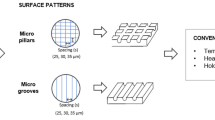Abstract
Zirconia-based dental implants are in direct contact with living tissues and any improvements in their bioactivity and adhesion to the tissues are highly welcome. In this study, different ratios of barium titanate (BT) were added to 3 mol% yttria-stabilized zirconia (3YSZ) through conventional sintering. The laser-texturing technique was also conducted to improve the biological performance of 3YSZ ceramics. The composition and the surface of the prepared composites were characterized by X-ray diffraction and scanning electron microscopy (SEM), respectively. The roughness and surface wettability of the composites were also measured. Furthermore, MC3T3-E1 pre-osteoblast cells were used for the in vitro experiments. Cell viability was evaluated using a commercial resazurin-based method. Morphology and cellular adhesion were observed using SEM. Based on the results, the laser texturing and the barium titanate content influenced the surface characteristics of the prepared composites. The laser-textured 3YSZ/7 mol% BT composites showed a lower water contact angle compared to the other samples, which indicated superior surface hydrophilicity. The cell viability and cell adhesion of 3YSZ/BT composites increased with the rise in the barium titanate content and laser power. An elongated cell morphology and apatite nucleation were also observed by the BT content. Overall, the laser-treated 3YSZ/5 and 7 mol% BT composites may be promising candidates in hard tissue repair due to their good cell response.












Similar content being viewed by others
References
Li Q, Li C, Wang Y. Effect of femtosecond laser ablate ultra-fine microgrooves on surface properties of dental zirconia materials. J Mech Behav Biomed Mater. 2022;134: 105361.
Shivakoti I, Kibria G, Cep R, Bahadur Pradhan B, Sharma A. Laser Surface Texturing for Biomedical Applications: A Review. Coatings. 2021;11:124.
Han J, Zhang F, Van Meerbeek B, Vleugels J, Braem A, Castagne S. Laser surface texturing of zirconia-based ceramics for dental applications: a review. Mater Sci Eng C. 2021;123: 112034.
Schünemann FH, Galárraga-Vinueza ME, Magini R, Fredel M, Silva F, Souza JCM, Zhange Y, Henriques B. Zirconia surface modifications for implant dentistry. Mater Sci Eng C. 2019;98:1294–305.
Hallmann L, Ulmer P, Wille S, Polonskyi O, Köbel S, Trottenberg T, Bornholdt S, Haase F, Kersten H, Kern M. Effect of surface treatments on the properties and morphological change of dental zirconia. J Prosthet Dent. 2016;115(3):341–9.
Cunha W, Carvalho O, Henriques B, Silva FS, Özcan M, Souza JCM. Surface modifcation of zirconia dental implants by laser texturing. Lasers Med Sci. 2022;37:77–93.
Hosseini MH, Etemadi A, Gorjizadeh F. Zirconia Surface Treatment by Different Output Powers of Er: YAG Laser and Sandblasting: SEM Evaluation. Iran J Ortho. 2017;12(2): e7267.
Tiainen LK. Design, Manufacturing & Analysis of Smart Ceramics for Biomedical Applications: Zirconia functionalization with barium titanate. PhD thesis, University of Minho, 2021.
Tandon B, Blaker JJ, Cartmell SH. Piezoelectric materials as stimulatory biomedical materials and scaffolds for bone repair. Acta biomaterialia. 2018;73(-):1–20.
Schult M, Buckow E, Seitz H. Experimental studies on 3d printing of barium titanate ceramics for medical applications. Current Directions in Biomedical Engineering. 2016;2(1):95–9.
Fan B, Guo Z, Lia X, Lib S, Gao P, Xiao X, Wu J, Shen C, Jiao Y, Hou W. Electroactive barium titanate coated titanium scaffold improves osteogenesis and osseointegration with low-intensity pulsed ultrasound for large segmental bone defects. Bioactive Mater. 2020;5(4):1087–101.
Seo S, Kishimoto A. Effect of polarization treatment on bending strength of barium titanate/zirconia composite. J Europ Ceram Soc. 2000;20:2427–31.
Yang B, Chen XM, Liu XQ. Effect of BaTiO3 addition on structures and mechanical properties of 3Y-TZP ceramics. J Europ Ceram Soc. 2000;20:1153–8.
Ghalandarzadeh A, Javadpour J, Majidian H, Ganjali M. The evaluation of prepared microstructure pattern by carbon-dioxide laser on zirconia-based ceramics for dental implant application: an in vitro study. Odontology. 2022;(https://doi.org/10.1007/s10266-022-00781-x. Online ahead of print).
Kokubo T, Takadama H. How useful is SBF in predicting in vivo bone bioactivity? Biomaterials. 2006;27(15):2907–15.
Yusoff NH, Osman RAM, Idris MS, Muhsen KNDK, Nor NIM. Dielectric and structural analysis of hexagonal and tetragonal phase BaTiO3. AIP Conference Proceedings, AIP Publishing LLC, 2020, p. 020038.
Carvalho A, Grenho L, Fernandes MH, Daskalova A, Trifonov A, Buchvarov I, Monteiro FJ. Femtosecond laser microstructuring of alumina toughened zirconia for surface functionalization of dental implants. Ceram Int. 2020;46(2):1383–9.
Rab A, Siraj K, Irshad M, Latif A, Naz S, Bashir S, Rafique M. Laser irradiation effects on structural, morphological and mechanical properties of ZirCAD dental ceramic. Dig J Nanomater Biostructures. 2021;16:677–84.
Kurtulmus-Yilmaz S, Aktore H. Effect of the application of surface treatments before and after sintering on the flexural strength, phase transformation and surface topography of zirconia. J Dent. 2018;72:29–38.
Roitero E, Ochoa M, Anglada M, Mücklich F, Jiménez-Piqué E. Low temperature degradation of laser patterned 3Y-TZP: Enhancement of resistance after thermal treatment. J Europ Ceram Soc. 2018;38(4):1742–9.
Kazemi M, Saghafian H, Hooshyar M. Evaluating the impacts of laser process parameters on microstructure and microhardness of H13-TiC composite using the mathematical modelling. SN Appl Sci. 2020;2(1942).
Pu Z, Jing X, Yang C, Wang F, Ehmann KF. Wettability modification of zirconia by laser surface texturing and silanization. Int J Appl Ceram Technol. 2020;17:2182–92.
Wenzel RN. Resistance of solid surfaces to wetting by water. Ind Eng Chem. 1936;28(8):988–94.
Moura CG, Pereira R, Buciumeanu M, Carvalho O, Bartolomeu F, Nascimento R, Silva FS. Effect of laser surface texturing on primary stability and surface properties of zirconia implants. Ceram Int. 2017;43(17):15227–36.
Xu J, Ji M, Li L, Wu Y, Yu Q, Chen M. Improving wettability, antibacterial and tribological behaviors of zirconia ceramics through surface texturing. Ceram Int. 2022;48(3):3702–10.
Katti DS, Vasita R, Shanmugam K. Improved biomaterials for tissue engineering applications: surface modification of polymers. Curr Top Med Chem. 2008;8(4):341–53.
Hao L, Lawrence J, Chian KS. Effects of CO2 laser irradiation on the surface properties of magnesia-partially stabilised zirconia (MgO-PSZ) bioceramic and the subsequent improvements in human osteoblast cell adhesion. J Biomater Appl. 2004;19(2):81–105.
Taniguchi Y, Kakura K, Yamamoto K, Kido H, Yamazaki J. Accelerated osteogenic differentiation and bone formation on zirconia with surface grooves created with fiber laser irradiation. Clin Implant Dent Relat Res. 2016;18(5):883–94.
Kostov KG, Nishime TMC, Castro AHR, Toth A, Hein LRO. Surface modification of polymeric materials by cold atmospheric plasma jet. Appl Surf Sci. 2014;314:367–75.
Zhu Y, Goh C, Shrestha A. Biomaterial properties modulating bone regeneration. Macromol Biosci. 2021;21(4):2000365.
Le X, Poinern GEJ, Ali N, Berry CM, Fawcett D. Engineering a biocompatible scaffold with either micrometer or nanometer scale surface topography for promoting protein adsorption and cellular response. Int J Biomater. 2013;(2013).
Li H, Wang X, Zhang J, Wang B, Breisch M, Hartmaier A, Rostotskyi I, Voznyy V, Liu Y. Experimental investigation of laser surface texturing and related biocompatibility of pure titanium. Int J Adv Manufactur Technol. 2022;1199–10:5993–6005.
Nikkhah M, Edalat F, Manoucheri S, Khademhosseini A. Engineering microscale topographies to control the cell–substrate interface. Biomater. 2012;33(21):5230–46.
Anselme K, Ploux L, Ponche A. Cell/material interfaces: influence of surface chemistry and surface topography on cell adhesion. J Adhesion Sci Technol. 2010;24(5):831–52.
Liu X, Wang Y, He Y, Wang X, Zhang R, Bachhuka A, Madathiparambil Visalakshan R, Feng Q, Vasilev K. Synergistic Effect of Surface Chemistry and Surface Topography Gradient on Osteogenic/Adipogenic Differentiation of hMSCs. ACS Appl Mater Interface. 2021;13(26):30306–16.
Zhou J, Zhang X, Sun J, Dang Z, Li J, Li X, Chen T. The effects of surface topography of nanostructure arrays on cell adhesion. Phys Chem Chem Phys. 2018;20(35):22946–51.
Al Qahtani WMS, Schille C, Spintzyk S, Al Qahtani MSA, Engel E, Geis-Gerstorfer J, Rupp F, Scheideler L. Effect of surface modification of zirconia on cell adhesion, metabolic activity and proliferation of human osteoblasts. 2017;62(1):75–87.
Trueba P, Giner M, Rodríguez Á, Beltrán AM, Amado JM, Montoya-Garcia MJ, Rodriguez-Albelo LM, Torres Y. Tribo-mechanical and cellular behavior of superficially modified porous titanium samples using femtosecond laser. Surf Coat Technol. 2021;422: 127555.
Sirdeshmukh N, Dongre G. Laser micro & nano surface texturing for enhancing osseointegration and antimicrobial effect of biomaterials: A review. Mater Today: Proceedings. 2021;44:2348–55.
Behera RR, Hasan A, Sankar MR, Pandey LM. Laser cladding with HA and functionally graded TiO2-HA precursors on Ti–6Al–4V alloy for enhancing bioactivity and cyto-compatibility. Surf Coat Technol. 2018;352:420–36.
Apablaza JA, Días FJ, Sánchez KG, Navarro P, Venegas C, Fuentes R. Analysis of the Chemical Composition and Morphological Characterization of Tissue Osseointegrated to a Dental Implant after 5 Years of Function. Int J Molecular Sci. 2022;23(16):8882.
Vallet-Regí M. Ceramics for medical applications. J Chemical Soc Dalton Trans. 2001;2:97–108.
Le Guéhennec L, Soueidan A, Layrolle P, Amouriq Y. Surface treatments of titanium dental implants for rapid osseointegration. Dental mater. 2007;23(7):844–54.
Chen X, Nouri A, Li Y, Lin J, Hodgson PD, Wen C. Effect of surface roughness of Ti, Zr, and TiZr on apatite precipitation from simulated body fluid. Biotechnol Bioeng. 2008;101(2):378–87.
Baino F, Yamaguchi S. The use of simulated body fluid (SBF) for assessing materials bioactivity in the context of tissue engineering: review and challenges. Biomimetics. 2020;5(4):57.
Sun Y, Sun J, Wu X, Li Y, Li X, Li R, Wang T, Bi W, Cui W, Yu Y. Mechanism of zirconia microgroove surface structure for osseointegration. Mater Today. 2021;12: 100159.
Han A, Tsoi JK, Lung CY, Matinlinna JP. An introduction of biological performance of zirconia with different surface characteristics: a review. Dent Mater J. 2020;39(4):523–30.
Hao L, Lawrence J, Chian K. Osteoblast cell adhesion on a laser modified zirconia based bioceramic. J Mater Sci Mater Med. 2005;16(8):719–26.
Acknowledgements
Financial support for this study was provided by Grant No. 391400010 from the Materials and Energy Research Center (MERC).
Funding
The work of Hudsa Majidian was supported by Materials and Energy Research Center, under Grant 391400010.
Author information
Authors and Affiliations
Corresponding author
Ethics declarations
Conflict of interest
All authors declare that they have no conflicts of interest.
Additional information
Publisher's Note
Springer Nature remains neutral with regard to jurisdictional claims in published maps and institutional affiliations.
Rights and permissions
Springer Nature or its licensor (e.g. a society or other partner) holds exclusive rights to this article under a publishing agreement with the author(s) or other rightsholder(s); author self-archiving of the accepted manuscript version of this article is solely governed by the terms of such publishing agreement and applicable law.
About this article
Cite this article
Majidian, H., Ghalandarzadeh, A., Kaboosi, M. et al. Influence of laser intensity and BaTiO3 content on the surface properties of 3YSZ. Odontology 112, 408–427 (2024). https://doi.org/10.1007/s10266-023-00853-6
Received:
Accepted:
Published:
Issue Date:
DOI: https://doi.org/10.1007/s10266-023-00853-6




